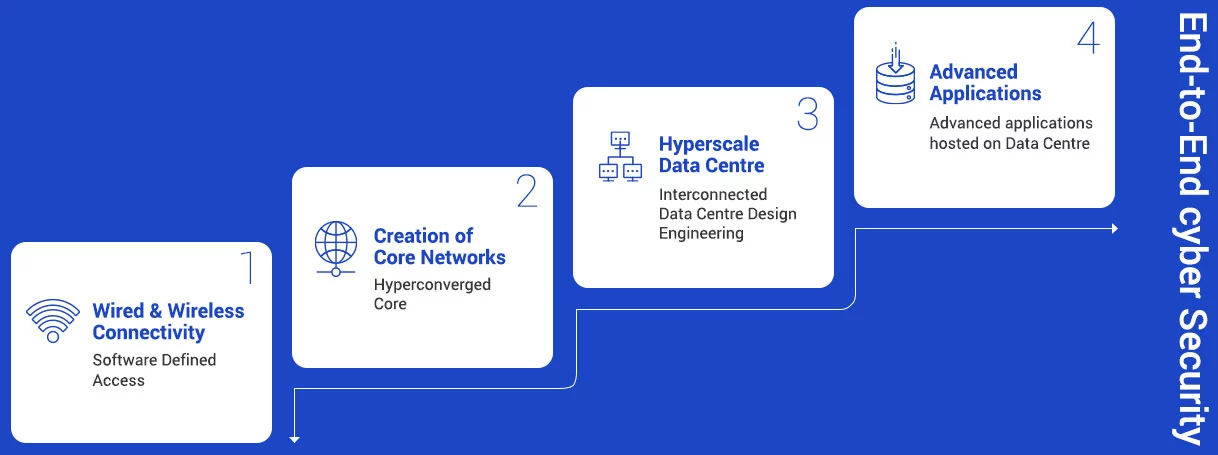
Aging networks present a number of issues, including decreased revenue, increased failure rates, a lack of standardization, interoperability, and reduced network security. Legacy networks severely restrict the capacity to respond to changing customer expectations, reducing their commercial potential.
Because network infrastructure is responsible for guaranteeing reliable and quick data access, there is enormous pressure on enterprise networks to support the performance of practically all technologies that sit on top. Read More..

One serious examination of today’s networks will reveal a sense of a specific structure, one that has followed a “build on top of legacy” strategy for network solutions.
As a result, there is a large scattering of resources in networks that have completed their lifecycles. Yet, CSPs continue to pay to run them for a variety of unknown purposes.
Some of the major obstacles preventing the present networks from shifting are as follows:
STL NetMode is a one-of-a-kind network modernization solution that consists of constructing networks and connecting users to the data processing layer at the data center. It consists of an access layer connecting to users with two distinct identities-software-defined wireless solutions and software-defined fixed access-aggregating at the converged MPLS network and connecting to the hyper-scale DC for data processing and storage.
Once the network is constructed, it is critical to maintain network security at all tiers and to monitor and manage the entire network, with the application layer playing a critical role. The solution is capable of designing and constructing end-to-end network solutions.
The five main building blocks of Modernization Network Solutions are:
1. Software Defined Access: The DNA (Digital Network Architecture) platform includes software-defined access. SD-Access automates user and device policy for any application across wireless (Software-Defined Radio, Network in a Box) and fixed access (Ethernet and FTTx Mantra) networks, providing network development architects with the tools to orchestrate key business functions such as onboarding, secure segmentation, IoT integration, and guest access.
2. Hyper Converged Core: Establishing a hyper-converged OTN/DWDM core transport network with an overlay of a software-defined routing-based MPLS network. OTN Hyper-converged solutions are the next-generation backbone of the transmission network, whereas DWDM is one of the most effective methods for increasing bandwidth over a present fiber plant.
3. Hyperscale Data Centre: Creating a network mesh of internet exchanges, interconnected data centers, and cloud service providers that are governed by an orchestration platform and our data design engineering experience. Hyperscale solutions fulfill enterprises’ expanding data demands and add extra resources to huge, dispersed computing networks without requiring additional cooling, electrical power, or physical space.
4. Applications: Each cloud-hosted application operates differently. To meet the same consumer demands, different apps may require different resources. A collection of apps hosted on agile and scalable data center solutions and enabled by sophisticated technologies like IoT, AI, analytics, and automation to ensure strong business performance while maintaining compliance and reporting.
5. Cyber Security: A comprehensive solution for securing end-to-end cyberinfrastructure, threat lifecycle management, and mitigating cyber threats and attacks spanning end-user, network, data center, cloud, and application layers. The framework promotes constant, real-time monitoring of all electronic resources to counteract the spread of harmful malware and aid in early identification. Read Less..

Fibre- roll out projects, especially in India has been slow paced. The fall-outs are evident in the time and cost overruns that plague large scale projects. Industry needs a robust solution that leverages Mechanisation, tool based project tracking and strategic partners to deliver stage wise excellence
STL promises to bring this stage wise excellence in the fibre rollout and deployment by our LEAD 360o solution. It is a first of its kind of orchestration approach for Hyperscale-Fibre deployment through innovation and best of our integration practises. The solution has the capability to deliver scale and coverage for core networks, mobile, home and rural.
STL has vast experience in network design and rollout especially in latest deployment technologies such as video surveys, geo-monitoring, sensors and analytics. Through our LEAD 360 o deployment approach we are creating a smarter digital network in rural areas as well by providing various smart applications including e-education, e-health and e-governance. We will continue to leverage our latest fibre deployment technologies to improve everyday living experiences of the citizens. Read Less..

Any major IT innovation, whether getting rid of a legacy phone inventory or transferring from old servers to the cloud, will have many moving components. Detailed planning, which entails mapping all interconnections and interfaces to ensure visibility into all resources, acts as the migration's blueprint.

The fundamental enabler for the goal of service convergence is different networks, programs, or rivals operating or interacting together without the requirement or use of additional tools or interfaces.

Customers no longer need to be concerned with the undifferentiated heavy lifting of infrastructure hardware and software upkeep.

Mobile computing makes use of both fixed and wireless networks. To connect established, wired communications systems, fixed networks frequently use radio transmission.
The distinction between fixed and wireless networks is that wireless networks do not require any cable to link the devices physically. It is a shared medium that is easily accessible. In the case of fixed networks, physical device configuration is required in order to perform data transfer. Every new device must be physically linked to the network separately.
Here are three reasons why firms with a good cyber infrastructure security strategy have a significant competitive advantage over those that do not.
1. Consumers are getting more security-aware
With cyber assaults and security breaches in the news, people are becoming increasingly skeptical about digital services and goods, whether from a huge corporation or a small business.
2. Security is required by partners
Before establishing and expanding their contacts with you, potential business partners and investors want to ensure that you have adequate cybersecurity solutions.
3. Cybersecurity is required for all other projects.
A solid cybersecurity strategy lays the groundwork for opportunities like transferring data and applications to the cloud, delivering managed services, and expanding into new markets.
Hyperscale data centers are massive, mission-critical facilities supporting robust and scalable applications. These one-of-a-kind data centers are frequently tied to corporations that require huge data processing, such as Google, Amazon, Facebook, IBM, Apple, Baidu, and Microsoft (GAFAM).
Traditional enterprise data centers are premises or buildings that hold business IT infrastructure, such as servers and equipment. Businesses often use these resources to conduct their own activities, but they can also be leased to other companies. On the other hand, a hyperscale data center easily outperforms them in terms of performance, capacity, and scalability.
Because of their expanded size and computational capacity, they readily outperform conventional facilities. The volume of data and storage capacity handled by hyperscale facilities vastly outnumbered that of enterprise facilities.
Cloud computing and services Investments are surpassing organization-wide on-premises infrastructure spending, forcing refresh and upgrade patterns to a halt. NTT revealed that over half of organizations' network infrastructure assets (47.3%) were aging or outmoded, reducing the network's ability to offer what businesses require. Many firms (60%) feel that network modernization will be central to their digital strategies by 2023 and that the network will be the platform for digital transformation.
Please wait while you are redirected to the right page...
